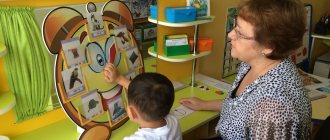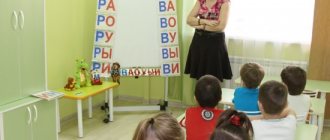For a small child, the world of sounds and coherent speech is very complex, so adults should help him in every possible way in the development of speech. But sometimes children do not master pronunciation, and their speech becomes incoherent and incomprehensible. This disrupts not only communication with the child, but also his further education, upbringing and development. Even if he does not have general developmental disorders, such a child will experience serious difficulties in learning, as well as psychological difficulties in communicating with peers and teaching staff. The feeling of one's own imperfection can lead to problems in the socialization and adaptation of children with speech defects, cause isolation, and in the future lead to even more serious complications in life. To prevent this from happening, the activities of a professional speech therapist and speech therapy work carried out by a kindergarten teacher are of great importance.
Their responsibilities are different. A speech therapist is a professional who sets the direction of activity, assigns pronunciation to children, develops and trains the speech apparatus so that the child can pronounce sounds that were previously absent in his speech or those that he pronounced with errors. The work of a teacher in the speech therapy group of a kindergarten, in general terms, is to support the work of the speech therapist, consolidate the acquired knowledge and skills in children, help them master complex sounds, and do this not from time to time, but on an ongoing basis. This means that the central place in the work on correcting speech disorders belongs to a speech therapist, and the teacher supports his activities in every possible way and helps children learn new knowledge and skills more easily and quickly.
The experience of working as a speech therapy group teacher is of great importance for children. A good specialist knows the specifics of his work very well, knows how to get along with children with special needs, cooperates competently with a speech therapist and helps students correct existing speech disorders faster and more productively.
Key responsibilities of a teacher
When working with children with speech disorders, the teacher is obliged to take measures to increase the vocabulary of preschoolers, eliminate agrammatisms, deficiencies in phoneme formation and incorrect pronunciation. Therefore, such pedagogical activities have unique features. Taking them into account, teachers and doctors effectively eliminate speech deficiencies, help children learn and integrate into society.
The key to success is coordinated correctional work in speech therapy groups. The teacher must examine each child immediately after joining the team and carefully study the medical recommendations. A thematic annual work plan is jointly drawn up, taking into account the age, knowledge and capabilities of the children.
A speech therapist corrects and improves speech communication. The responsibilities of the teacher include:
- control of children’s speech during classes and rest for effective mastery of it;
- performing speech therapy exercises, explaining them to parents - so that children expand their vocabulary and actively use it, reinforce correct sound pronunciation, develop fine and articulatory motor skills;
- conducting classes and organizing leisure time, taking into account parallel and individualized education for children;
- creation of psychologically comfortable conditions in the group for better speech formation and elimination of speech dysfunction in students.
Difficulties of working as a speech therapy group teacher
In order to most effectively plan and apply correctional work in the field of speech pathology in children, the teacher must understand the features of psychological processes associated with speech disorders:
- Problems with memory, attention, and the ability to concentrate on solving a specific problem.
- Disorders of articulatory and finger motor skills.
- Incomplete formation of verbal and logical thinking.
Since children with speech pathologies also have other deviations or developmental delays, this may manifest itself as follows:
- Students cannot reproduce the order of objects if they are rearranged. Sometimes children cannot cope with the sequence of arrangement of even 3-4 objects.
- Unable to find inconsistencies in paired drawings.
- Items that need to be sorted according to a certain criterion are not fully identified, for example, putting aside things made of wood, paper, fabric, and so on.
Such children are disinhibited, they cannot concentrate on one action or object for more than a few minutes, and they get tired very quickly, so a teacher in a group for students with speech disorders will need to visually reinforce their actions. He will also have to use simpler speech structures, explain his actions as briefly and clearly as possible for children of the appropriate age and level of knowledge, and give them rest between exercises. Children with such features remember everything much more easily at an involuntary level than at a voluntary level, so all activities need to be structured in a light playful way in order to interest children in what is happening.
Problems with articulatory motor skills are manifested in the physical limitation of movements of parts of the speech apparatus: tongue, lips, soft palate, lower jaw, therefore, on the advice of a speech therapist, classes on the development of these parts of the body in the form of special speech gymnastics should be included in the work hours of the teacher in the speech therapy group.
Speech disorders are often combined with other developmental problems, for example, they are associated with underdevelopment of fine motor skills. That is why experienced specialists insist that the development of motor skills be stimulated in every possible way in children with similar problems. Such children have constrained movements, do not know how to lace their own shoes or fasten the buttons on their own clothes, hold cutlery not with their fingers, but clasp it in their fist, and also take other utensils, for example, they cannot use drawing brushes, pencils and felt-tip pens correctly.
Pupils with speech underdevelopment have indicators of general development below their age norm. The difference is not too noticeable, but it will worsen as children grow older, unless correct and systematic correction is applied. In order for a child to develop correctly, he definitely needs to develop speech and correct all its violations. To do this, the teacher will have to demonstrate not only his educational abilities and professional knowledge, but also purely human positive qualities.
In speech therapy groups there are children with different behavior and psychological characteristics. Some of them quickly become distracted, begin to get bored, not pay attention to what is happening, fidget, or sit apathetically in a corner. Others show signs of irritation and aggression and react painfully to the teacher’s comments. So, in order to find an individual approach to each child, the teacher will take a lot of effort, time and patience, and will need all possible tolerance and endurance. To work with such groups, you need to really love children and care about their well-being.
The working week according to the work schedule of a speech therapy group teacher, due to the high workload on the employee, is a total of 25 hours, that is, 5 hours a day for a five-day week. If the teacher overworks, his rate is recalculated and an additional 20% is paid for working with the speech therapy group.
Effective speech development
When working, a teacher of speech therapy groups on the speech development of preschool children must use all types of communication - initiated by adults and spontaneous. You need to ask each child questions, not stop him when he wants to speak, and encourage initiative in conversation. In order for children to master speech faster, the teacher must:
- listen to children’s conversations and be able to identify deficiencies in phonetics and grammar in speech;
- engage in the education of pupils continuously, taking into account the lexical topics given by the speech therapist - in this case, the teacher’s speech should be intelligible, with expressive intonations and emphasized articulation;
- provide a cognitive base - study various topics with children so that children master the minimum vocabulary and learn everything they need for impressive and expressive speech;
- stimulate interest in the conversation, involve students in it, maintain a conversation not only in class, but also on walks, games, and during quiet rest.
A clear example of the specifics of a teacher’s work is the coordination of numerals with nouns. The speech therapist introduces the pupils to speech forms, and the teachers do exercises - how to use the adverbs “little” and “many” with numerals, how to use the genitive, accusative case, etc.
Carrying out speech therapist tasks
The most important part of a teacher’s work is reinforcing the skills that a speech therapist instills in children. To correct deviations, “five-minute speech therapy sessions,” games, and exercises are used. The format is chosen depending on the schedule of classes and other activities of the children.
“Five-minute lessons” are short, emotionally pleasing training sessions for children that correspond to the lexical topic that the speech therapist has planned to study. They help develop all components of speech and consolidate specific skills. After lunch, to fill the pauses, it is recommended to use game exercises, specially developed by a speech therapist.
Before lunch and after bedtime, it is necessary to pay individual attention to each child. It is important to organize work in parallel - one student, for example, studies personally, while others rest under the supervision of a junior specialist. 10-15 minutes are allotted for individual exercises with the child. These classes are regularly attended by a speech therapist to monitor the results and make corrections if necessary.
To consolidate the acquired speech skill, the teacher offers children articulation gymnastics and gives them speech therapy exercises for:
- coordination of movements with speech;
- consolidation and differentiation of correctly pronounced sounds;
- staging speech breathing;
- development of the ability to remember, attentiveness, phonemic hearing, fine motor skills;
- developing the skill of writing descriptions (using mnemonic tables).
Features of interaction between a speech therapist and educator in modern conditions of a preschool educational institution
Features of interaction between a speech therapist and educator in modern conditions of a preschool educational institution.
Abstract: Organization of comprehensive correctional work to overcome speech disorders in children with the participation of specialists of various profiles is an urgent task. Its successful solution is possible only if there is unity of requirements imposed by the educator and the speech therapist. Taking this into account, the creation of a system of interaction between preschool education specialists deserves special attention.
A distinctive feature of the educational process with children with speech disorders is that in addition to teaching, development, and educational tasks, the teacher also faces correctional tasks. The teacher is actively involved in eliminating speech defects in preschoolers. Therefore, the choice of methods and means of interaction with pupils of this category is important in their training and education.
The formation of correct speech is of great importance for the development of a child’s full personality. The preschooler’s consistent mastery of all components of speech without accelerating this process will in the future become the key to his successful learning at school. At the same time, the effectiveness of work on the development of children’s speech directly depends on the ability of the speech therapist and educator to plan it competently.
Taking this into account, the creation of a system of interaction between preschool education specialists deserves special attention. The process of interaction in the conditions of a modern preschool educational institution must be fine-tuned both in form (the presence of a partnership, understanding of the interests and professional tasks of the parties) and in content (the creation of joint programs to optimize the development of children).
When developing the content of activities in this direction, it was taken into account that the interaction process should be based on the principles of partnership, dialogism, as well as complementarity and continuity. Therefore, during the school year, meetings were held during which educators and the speech therapist teacher exchanged opinions on the forms and content of joint work and the process of preparing children for school.
At the beginning of the school year, the speech therapist teacher introduces the results of the examination of children, as well as the program of correctional work for the school year, explains the goals, objectives and methods of implementing the program, determines the timing and duration of its implementation, and conducts a joint discussion of ways to implement the assigned rehabilitation tasks children with speech disorders. When determining the content of correctional and developmental work, a long-term plan is discussed, and the most rational methods for carrying out speech correction for each child are specified.
Target:
- building a unified system of interaction between a speech therapist and preschool educators
Tasks:
- Develop unified (variable) approaches to the interaction between a speech therapist and a preschool teacher.
- Select new effective and exchange existing forms of interaction in a specialized preschool educational institution.
- To delimit the areas of responsibility of the speech therapist and preschool teachers in correctional and developmental work.
- Select software for interaction between a speech therapist and teacher using ICT.
Work plan:
Interaction between a speech therapist and educators during diagnosis, determination of volumes and spheres of influence, forms of cooperation.
Interaction between a speech therapist and educators during correctional and developmental activities, forms of cooperation.
Functionality of a speech therapist and educators.
Building interaction using information and computer technologies.
Planned result: selection and development of unified (variable) approaches to the interaction between a speech therapist and preschool teachers.
The coordinated work of a speech therapist and educators is based on the following principles:
- The principle of an integrated approach to the organization of the correctional pedagogical process.
- The principle of unity of diagnosis and direct correctional pedagogical process
- The principle of cooperation between the speech therapist teacher, educators and children
- The principle of taking into account the interests of all participants in the correctional pedagogical process.
- The principle of a differentiated approach to logopaths in the process of educating them to correct speech.
For ease of use, we have developed:
- Long-term plan for interaction with specialists.
- Notebooks for interaction with teachers of compensatory groups for organizing correctional and developmental work in the afternoon.
- A sound screen that displays the stages of work on speech sounds for each child.
Joint correctional work in a speech group involves solving the following tasks:
- Speech therapist forms primary speech skills in children-speech therapists
- The teacher consolidates the formed speech skills
Main types of organization of joint activities of a speech therapist and teacher
1. Joint study of the content of the training and education program in a special preschool institution and drawing up a joint work plan.
2. Joint planning of the teacher’s classes, ensuring the necessary consolidation of the material in various types of children’s activities.
3. Discussion of the results of joint study of children, which was conducted in the classroom and in everyday life.
4. Joint preparation for all children's holidays (the speech therapist selects speech material, and the teacher consolidates it).
5. Development of general recommendations for parents.
A speech therapist teacher must not only teach educators how to work with each child, but also monitor the implementation of his recommendations. The relationship notebook, where the speech therapist teacher enters his assignments, is filled out once a week.
The content of the work is revealed in three sections:
1. Five-minute speech therapy sessions.
2. Games and exercises.
3. Corrective and developmental activities in an individual form.
Speech therapy five-minute sessions can be used by teachers in different situations and other activities. Five minutes should be short enough, they should not be turned into a long process. They should be carried out in a playful and entertaining way against a good emotional background. Five-minute sessions should correspond to the lexical topic studied during the week and contribute to the development of all components of speech in children. The speech therapist teacher, in turn, must indicate the goals and objectives that are pursued when performing each task, and give a detailed description of them.
Games and exercises recommended by a speech therapist can be taught by teachers in the afternoon or used during dynamic breaks.
Corrective and developmental activities in an individual form are carried out by the teacher, both in the first and second half of the day. Every day, the teacher works with 2-3 children and conducts articulatory gymnastics, tasks on automation and differentiation of sounds, as well as tasks on those sections of the program that children learn with the greatest difficulty. Considering that teachers have card indexes of games, exercises for the development of visual and auditory attention (memory), fine motor skills, exercises for the development of coordination of speech with movement, and each card in the card index has its own number, the speech therapist only needs to indicate the card number. This makes it easier for the speech therapist to write daily assignments for educators.
A speech therapist teacher observes the work of a teacher with children, attending direct educational activities, noting positive aspects, and also analyzes those types of work that were unsuccessful and did not give the expected result. Such visits show the teacher-speech therapist a complete picture of correctional and developmental work, expands their understanding of correctional work, they master the techniques, methods, and teaching technologies that the specialist owns.
Only a close relationship in the work of a speech therapist and educators makes it possible to achieve positive results in correcting the speech of preschoolers.
Interaction between a speech therapist and a teacher using ICT
- Conducting finger games with children and breathing exercises using a computer by the teacher of the speech therapy group during scheduled moments and during the speech therapy hour in the afternoon, on the recommendation of the speech therapist
- the use of a certain video sequence (for example, picture material on lexical topics) for demonstration in complex classes conducted jointly by a teacher and a speech therapist of a speech therapy group, as well as for the teacher to reinforce educational material in his classes and during scheduled moments in the afternoon
- the use of various speech therapy games and exercises in individual lessons of the teacher on the instructions of the speech therapist.
Speech therapy classes using computer programs and technologies are conducted in compliance with SanPiNov standards:
- using new computer models
- working with a computer in one lesson for a short time (5-10 minutes) and no more than twice a week (individually, depending on the age of the child, his nervous system)
- Carrying out hygienic exercises for the eyes; while working, we periodically move the child’s gaze from the monitor every 1.5 - 2 minutes for a few seconds
- inclusion in speech therapy classes of games aimed at preventing visual impairment and developing visual-spatial relationships
At the end of the school year, final meetings between educators and the speech therapist are held, during which difficulties in organizing joint correctional and educational work are discussed, the effectiveness and prospects of activities are determined, and the dynamics of children’s development are assessed.
It should be noted that the interaction between teachers and speech therapists organized in this way made it possible to ensure positive dynamics in the speech development of children, which is one of the key indicators of children’s readiness for school.
Yaroshenko L.Yu., speech therapist
- Interaction between the music director, speech therapist and educator
- Plan of interaction between a speech therapist and participants in the correctional pedagogical process
- The relationship between the work of a speech therapist teacher and a teacher in a speech therapy group for children with special needs development disorders (from work experience)
- Self-analysis of the work of a teacher-speech therapist on the methodological topic: “Modern forms of interaction between teacher-speech therapist and family”
- The use of modern educational technologies in the practical activities of a preschool teacher-speech therapist
( 1 liked, average score: 5.00 out of 5)
Loading...
Creating a motivating atmosphere in the group
In order for children to believe in themselves and their capabilities, the atmosphere in the group should be as friendly as possible. The duty of the teacher is to eliminate negative emotions associated with speech dysfunction, to develop motivation for work and interest in work in each child. To create the correct psychological “background” you need:
- develop behavioral skills in children in a preschool group;
- notice and respond in a timely manner to manifestations of aggression, passivity, and conflicts;
- develop in children normal ethical and moral ideas about life and interaction with people;
- encourage initiative and good behavior.
You can obtain the profession of a teacher working with children with speech therapy disorders at the ANPOO "NSPK". For admission you do not need to pass the Unified State Exam, there are no entrance exams. Training is conducted remotely*, under an official educational license. The graduate will receive two diplomas at once - about secondary vocational education and professional retraining - and his value in the labor market will be high. Information about admission and promotions for applicants can be obtained from the admissions committee of the ANPOO "NSPK".
* Form of study – correspondence. Educational programs are implemented using e-learning and distance learning technologies.





